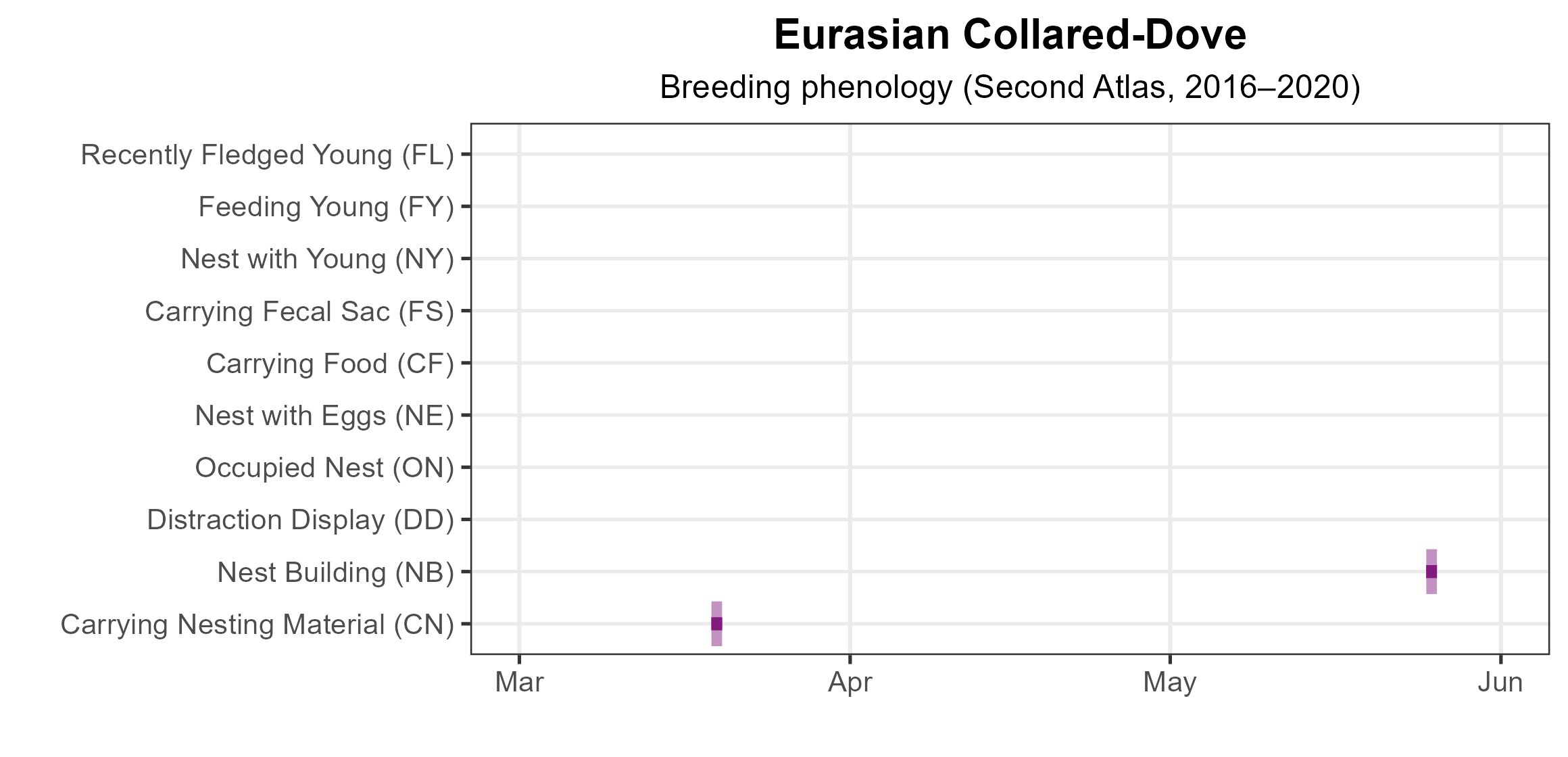Introduction
The Eurasian Collared-Dove is one of the more recent non-native avian species to breed in Virginia, as it was not recorded breeding during the First Atlas. In the 1970s, Eurasian Collared-Doves escaped from a pet store in the Bahamas and were inhabiting Florida by the 1980s. In the following decades, the species colonized much of the U.S., from coastal regions in the southeast to the entire West Coast and even to Alaska (Romagosa and Mlodinow 2022).
In Virginia, the first records were obtained in the early 2000s, and breeding was first documented in 2002 on the Eastern Shore near Kiptopeke (Rottenborn and Brinkley 2007). Far from becoming the next European Starling (Sturnus vulgaris) or House Sparrow (Passer domesticus), Eurasian Collared-Doves have remained relatively contained to a few localized sites in the state, albeit with gradual expansion.
Eurasian Collared-Doves prefer open and semi-open habitats where they pick grain in agricultural fields (Romagosa and Mlodinow 2022). In Virginia, they are most often seen at birdfeeders in yards in southern Northampton County and several cities in the mountains.
Breeding Distribution
Although the Eurasian Collared-Dove ranges as far north as Ontario in eastern North America, it remains rare in Virginia. A lack of breeding observations prevented the development of distribution models for Eurasian Collared-Doves. For more information on where this species occurs in Virginia, see the Breeding Evidence section.
Breeding Evidence
Eurasian Collared-Doves were observed in several locations in all three main regions of the state, but breeding was confirmed in only two blocks in the Mountains and Valleys region: one in Rockingham County outside of Harrisonburg and one in Washington County in the town of Meadowview (Figure 1). Probable breeders were detected in an additional four counties (Amelia, Montgomery, Northampton, and Wythe). Despite the population in yards along Magotha Road in Northampton County being one of the better-known spots for birders seeking this species, breeding was not confirmed there. The species did not occur in Virginia during the First Atlas.
Breeding phenology in the state is unclear, as only two confirmed breeding observations were recorded during the Second Atlas. Adults were carrying nesting material on March 19, and nest building was confirmed on May 25 (Figure 2).
For more general information on the breeding habits of this species, please refer to All About Birds.

Figure 1: Eurasian Collared-Dove breeding observations from the Second Atlas (2016–2020). The colored boxes illustrate Atlas blocks (approximately 10 mi2 [26 km2] survey units) where the species was detected. The colors show the highest breeding category recorded in a block. The numbers within the colors in the legend correspond to the number of blocks with that breeding evidence category.

Figure 2: Eurasian Collared-Dove phenology: confirmed breeding codes. This graph shows a timeline of confirmed breeding behaviors. Tick marks represent individual observations of the behavior.
Population Status
Due to its rarity in the state and thus a lack of point count data, an abundance model could not be developed for the Eurasian Collared-Dove. Similarly, no estimates of population trends are available from the North American Breeding Bird Survey.
Conservation
Given that Eurasian Collared-Dove is a non-native species in Virginia, it is important to continue tracking its distribution and abundance through efforts such as this Breeding Bird Atlas and eBird. To date, there is little evidence that they have displaced other doves or have negative effects on native species. In Florida, they have been found to be positively associated with other species: where there are more Collared-Doves, there are also more Mourning Doves (Zenaida macroura) (Bonter et al. 2010).
It is unclear exactly why Eurasian Collared-Doves have not become successful and widespread in Virginia. It is likely that habitat and climatic conditions are unsuitable in many areas of Virginia, slowing their rate of colonization. Data from Project FeederWatch have shown that the species has a preference for warm, wet grassland habitat (Shao et al. 2024). For the most part, they are currently confined to urban and rural to suburban yards at well-known sites. Observers should continue to report Collared-Doves as they appear in new areas.
Interactive Map
The interactive map contains up to six Atlas layers (probability of occurrence for the First and Second Atlases, change in probability of occurrence between Atlases, breeding evidence for the First and Second Atlases, and abundance for the Second Atlas) that can be viewed one at a time. To view an Atlas map layer, mouse over the layer box in the upper left. County lines and physiographic regional boundaries (Mountains and Valleys, Piedmont, and Coastal Plain) can be turned on and off by checking or unchecking the box below the layer box. Within the map window, users can hover on a block to see its value for each layer and pan and zoom to see roads, towns, and other features of interest that are visible beneath a selected layer.
View Interactive Map in Full Screen
References
Bonter, D. N., B. Zuckerberg, and J. K. Dickinson (2010). Invasive birds in a novel landscape: habitat associations and effects on established species. Ecography 33:494–502.
Romagosa, C. M., and S. G. Mlodinow (2022). Eurasian Collared-Dove (Streptopelia decaocto), version 1.1. In Birds of the World (P. Pyle, P. G. Rodewald, and S. M. Billerman, Editors). Cornell Lab of Ornithology, Ithaca, NY, USA. https://doi.org/10.2173/bow.eucdov.01.1.
Rottenborn, S. C., and E. S. Brinkley (Editors) (2007). Virginia’s birdlife: an annotated checklist, 4th edition. Virginia Society of Ornithology.
Shao, Y., D. M. Ethier, and S. J. Bonner (2024). Invasion dynamics of the European Collared-Dove in North America are explained by combined effects of habitat and climate. Ornithological Applications 126.

